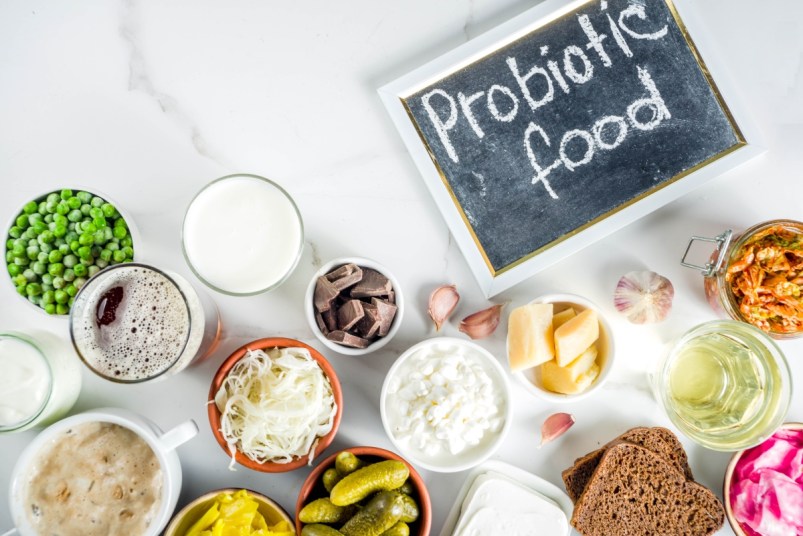Walk Off the Weight Using Probiotics — Here’s How
A combo of walking and probiotic-rich foods might be your weight loss ticket.

Want to walk off some weight? A top natural health expert is sharing a surprising way to do just that. “The key is getting more probiotics,” reveals Josh Axe, D.C., D.N.M., bestselling author of Ancient Remedies. Whether you snack on probiotic-rich yogurt and pickles or simply opt for a supplement, new evidence shows the strategy may help a walker’s body burn more fat. Real-world results are impressive too: “My mom, Winona, used a combination of walking, probiotic-rich foods, and a supplement to lose 25 pounds,” shares Dr. Axe.
For anyone not sure what probiotics are, “they’re good bacteria that live in the digestive tract,” explains Dr. Axe. “Each of us has more bacteria in our guts than there are cells in our entire body — and we need them for survival.”
From fighting tooth decay to heart disease and cancer, probiotics have a key superpower that delivers hundreds of benefits: “They make it possible for us to absorb really crucial nutrients from food,” says the doc. Without the right gut bacteria, “you might not absorb the iodine, selenium, and vitamin D necessary for optimal thyroid function and metabolism.” If you lack bacteria to help with protein and B vitamins, firm muscle can turn to flab. And if you can’t absorb minerals like chromium and magnesium, you may wind up with serious and fattening blood-sugar issues. “It’s a really big deal,” he notes.
Of course, it makes sense probiotic-rich food and supplements can help. But many of us have tried them with limited success. The difference maker, according to Dr. Axe: Using walks to turbocharge your probiotics.
How Walking Increases Probiotics’ Benefits
How can moving your feet possibly impact microscopic organisms in your gut? For starters, “walking increases blood flow to every part of you, including your gut. And that helps probiotics thrive,” says Dr. Axe. Walking also cuts levels of probiotic-damaging stress hormones. And there are other potential reasons too. For example, exercise creates compounds called lactates, which scientists think may fuel certain bacteria.
As good bacteria flourish, their benefits — including helping us burn fat — amp up and up. “The combination of probiotics and walking can transform your life,” Dr. Axe concludes.
Dr. Axe’s Easy Rx: How Much To Walk and What To Eat
Getting started is easy. Just get moving, working up to 30 minutes of walking at once or a total of 10,000 steps most days. “Your pace should feel good, because pushing too hard stresses the body and can stall progress,” cautions Dr. Axe.
He also recommends at least one daily serving of food with live and active cultures — such as yogurt, kefir, or varieties of pickles and sauerkraut made without vinegar (which kills probiotics; look for options in a store’s refrigerated section). Try some kefir smoothies to start.
“It’s good to eat a variety, since each food contains strains with different benefits,” Dr. Axe recommends. For example, he says sauerkraut is the best source of L. plantarum, the specific probiotic that helped walkers spike fat burn and build more muscle in the recent Taiwanese study. Meanwhile yogurt tends to contain fat-fighting L. acidopholus and kefir has up to 61 different types of probiotics, including waist-shrinking L. reuteri.
Another great option is a daily supplement. To spur weight loss, Dr. Axe recommends a daily probiotic supplement, such as SBO Probiotics Ultimate. He suggests you look for formulas labeled with at least 25 billion CFUs and that contain strains like B. Clausii and S. Boulardii. He adds that eating a diet with lots of fiber helps ‘feed’ the probiotics after you eat them. And limiting sugar and refined carbs keeps bad bacteria at bay.
Finally, Dr. Axe emphasizes steady, sustainable progress and overall health. Be sure to always get a doctor’s okay before trying any new diet or supplement. Click through to learn how probiotics can also ease menopause symptoms.
This content is not a substitute for professional medical advice or diagnosis. Always consult your physician before pursuing any treatment plan.
A version of this article originally appeared in our print magazine, Woman’s World.












